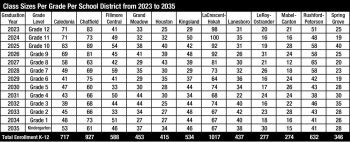 Back in 2010, the Fillmore County Journal published an article sharing the projected graduating class sizes per school district in the immediate newspaper coverage area.
Back in 2010, the Fillmore County Journal published an article sharing the projected graduating class sizes per school district in the immediate newspaper coverage area.
At that time, schools were experiencing an influx of students in their preschool programs, anticipating the need for more teachers as a result of what became coined the “Baby Boomlet” of 2007. With the economy doing well around 2005 to 2007, consumer confidence was up, and families were growing. It was the single greatest spike in births since the peak years of the Baby Boomer generation – which was 1957. Exactly 50 years later, in 2007, there was a baby bump that only lasted one year, and then fell in tandem with the crashing economy.
As a point of comparison, there were 4,316,233 births in the United States in 2007, edging out the Baby Boomer record set in 1957 with 4.3 million births. Compare those numbers to 2021, when there were 3,659,289 births. That’s more than a 15% decline in births.
Right now, the kids who were born in 2007 as part of the Baby Boomlet crowd are getting their learner’s permits. They are driving cars. And the DMV will be flooded with higher than usual driving tests.
But, what do the next 13 years look like for area schools?
According to reports provided in October and November of 2022 from school districts in the tri-county (Fillmore, Houston and Mower) region, there are mixed projections. Collectively, from the Class of 2023 to 2035, 12 combined school districts show a net decline of 26 students. Charting these numbers over the next 13 years, numbers show an initial steady decline between now and 2028, and then a plateau that starts to level off with the Class of 2029. In some cases, there is a slight increase beyond 2029.
Caledonia Public Schools
The 10th Graders at Caledonia Public School have the most number of students enrolled with 83, while third graders have less than half of the class size at 39 students.
Chatfield Public Schools
Chatfield’s Class of 2025 is currently slated for 89 students, compared to 61 students for the Class of 2035. Out of 12 school districts in the Journal coverage area, they are the second largest school district with 927 students.
Fillmore Central Public Schools
With the combination of Fountain, Harmony, and Preston, FC will have graduating class sizes ranging from 33 to 59 over the next 13 years – an average of 45 students per class.
Grand Meadow Public Schools
Home of the Superlarks, Grand Meadow is anticipating graduating class sizes of 27 to 44 students between now and 2035.
Houston Public Schools
Houston will be hovering between 25 and 43 graduates each year over the next 13 years. Houston also, uniquely, has 1,834 students enrolled in the Minnesota Virtual Academy – an online school also under the umbrella of responsibility for the Houston Public Schools.
Kingsland Public Schools
From 2023 to 2035, Kingsland (drawing from Spring Valley and Wykoff) will remain steady, averaging approximately 41 students per graduating class.
LaCrescent-Hokah Public Schools
The L-H enrollment will celebrate graduation with 100 students in 2024. By 2029, the graduating class size drops to 64 students. On average, L-H will maintain an average of 78 students per graduating class over the next 13 years. LaCrescent-Hokah is the largest school district in the Journal coverage area with 1,017 students.
Lanesboro Public Schools
Burro country is projected to average 34 students graduating class sizes, ranging from 22 to 42 students per class. Historically, Lanesboro draws about one-third of their students from other schools via the option of open enrollment.
LeRoy-Ostrander Public Schools
L-O has the second lowest enrollment of any school district in the Fillmore County Journal coverage area, averaging 21 students per graduating class. Class sizes range from 16 to 31 students.
Mabel-Canton Public Schools
Small but mighty, M-C has a total enrollment of 274 students from kindergarten through 12th grade, averaging 21 students per graduating class.
Rushford-Peterson Public Schools
The third largest school district in the tri-county region, R-P will average 49 graduates per year for the next 13 years, with graduating class sizes ranging from 41 to 65 students.
Spring Grove Public Schools
Averaging 27 graduates per year over the next 13 years, Spring Grove will see fluctuations from 19 to 40 graduates per year.


Anonymous says
you should run these numbers again and see if they have changed at all over the last 2-1/2 years